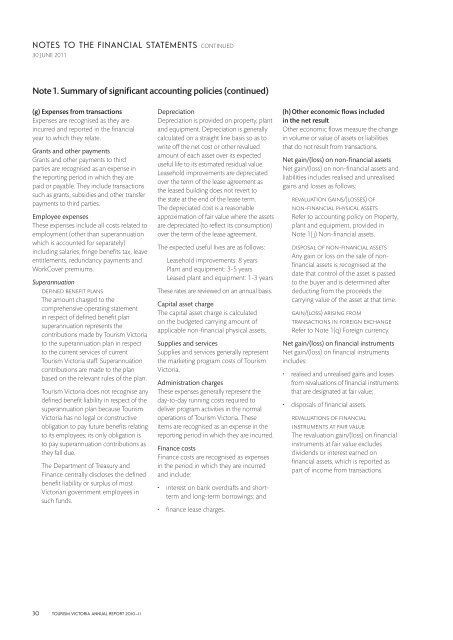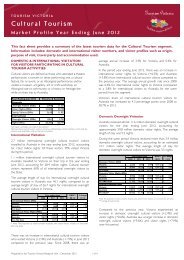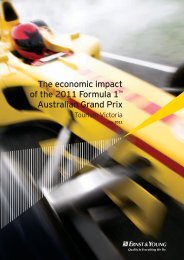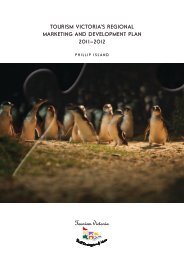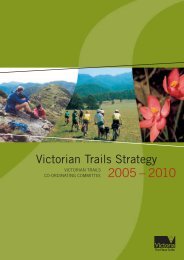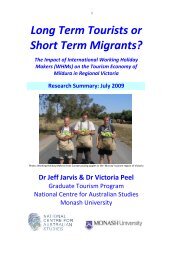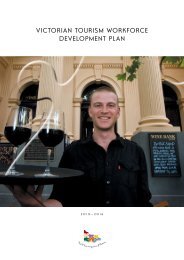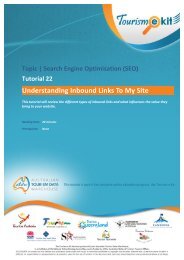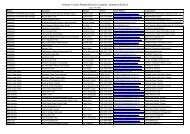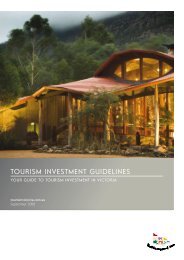Annual Report 2010–2011, Part 2: Financial (1.8 ... - Tourism Victoria
Annual Report 2010–2011, Part 2: Financial (1.8 ... - Tourism Victoria
Annual Report 2010–2011, Part 2: Financial (1.8 ... - Tourism Victoria
You also want an ePaper? Increase the reach of your titles
YUMPU automatically turns print PDFs into web optimized ePapers that Google loves.
NOTES TO THE FINANCIAL STATEMENTS CONTINUED<br />
30 JUNE 2011<br />
Note 1. Summary of significant accounting policies (continued)<br />
(g) Expenses from transactions<br />
Expenses are recognised as they are<br />
incurred and reported in the financial<br />
year to which they relate.<br />
Grants and other payments<br />
Grants and other payments to third<br />
parties are recognised as an expense in<br />
the reporting period in which they are<br />
paid or payable. They include transactions<br />
such as grants, subsidies and other transfer<br />
payments to third parties.<br />
Employee expenses<br />
These expenses include all costs related to<br />
employment (other than superannuation<br />
which is accounted for separately)<br />
including salaries, fringe benefits tax, leave<br />
entitlements, redundancy payments and<br />
WorkCover premiums.<br />
Superannuation<br />
Defined benefit plans<br />
The amount charged to the<br />
comprehensive operating statement<br />
in respect of defined benefit plan<br />
superannuation represents the<br />
contributions made by <strong>Tourism</strong> <strong>Victoria</strong><br />
to the superannuation plan in respect<br />
to the current services of current<br />
<strong>Tourism</strong> <strong>Victoria</strong> staff. Superannuation<br />
contributions are made to the plan<br />
based on the relevant rules of the plan.<br />
<strong>Tourism</strong> <strong>Victoria</strong> does not recognise any<br />
defined benefit liability in respect of the<br />
superannuation plan because <strong>Tourism</strong><br />
<strong>Victoria</strong> has no legal or constructive<br />
obligation to pay future benefits relating<br />
to its employees; its only obligation is<br />
to pay superannuation contributions as<br />
they fall due.<br />
The Department of Treasury and<br />
Finance centrally discloses the defined<br />
benefit liability or surplus of most<br />
<strong>Victoria</strong>n government employees in<br />
such funds.<br />
Depreciation<br />
Depreciation is provided on property, plant<br />
and equipment. Depreciation is generally<br />
calculated on a straight line basis so as to<br />
write off the net cost or other revalued<br />
amount of each asset over its expected<br />
useful life to its estimated residual value.<br />
Leasehold improvements are depreciated<br />
over the term of the lease agreement as<br />
the leased building does not revert to<br />
the state at the end of the lease term.<br />
The depreciated cost is a reasonable<br />
approximation of fair value where the assets<br />
are depreciated (to reflect its consumption)<br />
over the term of the lease agreement.<br />
The expected useful lives are as follows:<br />
Leasehold improvements: 8 years<br />
Plant and equipment: 3-5 years<br />
Leased plant and equipment: 1-3 years<br />
These rates are reviewed on an annual basis.<br />
Capital asset charge<br />
The capital asset charge is calculated<br />
on the budgeted carrying amount of<br />
applicable non-financial physical assets.<br />
Supplies and services<br />
Supplies and services generally represent<br />
the marketing program costs of <strong>Tourism</strong><br />
<strong>Victoria</strong>.<br />
Administration charges<br />
These expenses generally represent the<br />
day-to-day running costs required to<br />
deliver program activities in the normal<br />
operations of <strong>Tourism</strong> <strong>Victoria</strong>. These<br />
items are recognised as an expense in the<br />
reporting period in which they are incurred.<br />
Finance costs<br />
Finance costs are recognised as expenses<br />
in the period in which they are incurred<br />
and include:<br />
• interest on bank overdrafts and shortterm<br />
and long-term borrowings; and<br />
• finance lease charges.<br />
(h) Other economic flows included<br />
in the net result<br />
Other economic flows measure the change<br />
in volume or value of assets or liabilities<br />
that do not result from transactions.<br />
Net gain/(loss) on non-financial assets<br />
Net gain/(loss) on non-financial assets and<br />
liabilities includes realised and unrealised<br />
gains and losses as follows:<br />
Revaluation gains/(losses) of<br />
non-financial physical assets<br />
Refer to accounting policy on Property,<br />
plant and equipment, provided in<br />
Note 1( j) Non-financial assets.<br />
Disposal of non-financial assets<br />
Any gain or loss on the sale of nonfinancial<br />
assets is recognised at the<br />
date that control of the asset is passed<br />
to the buyer and is determined after<br />
deducting from the proceeds the<br />
carrying value of the asset at that time.<br />
Gain/(loss) arising from<br />
transactions in foreign exchange<br />
Refer to Note 1(q) Foreign currency.<br />
Net gain/(loss) on financial instruments<br />
Net gain/(loss) on financial instruments<br />
includes:<br />
• realised and unrealised gains and losses<br />
from revaluations of financial instruments<br />
that are designated at fair value;<br />
• disposals of financial assets.<br />
Revaluations of financial<br />
instruments at fair value<br />
The revaluation gain/(loss) on financial<br />
instruments at fair value excludes<br />
dividends or interest earned on<br />
financial assets, which is reported as<br />
part of income from transactions.<br />
30 TOURISM VICTORIA ANNUAL REPORT 2010–11


